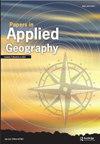City Resilience to COVID-19 in Yangtze River Delta Urban Agglomeration Based on the Perspective of Human Mobility and Fisher Information Method
Q2 Social Sciences
引用次数: 3
Abstract
Abstract The COVID-19 pandemic that broke out in early 2020 has severely impacted domestic production and quality of life in Chinese cities. Taking the Yangtze River Delta Urban Agglomeration as an example, this study takes Baidu migration data of mobility-within-city and mobility-between-cities as observation variables, adopts Fisher Information and resilience surrogate methods, and quantitatively analyzes the resilience of the urban agglomeration during the pandemic. The results show the changes in mobility-within-city and mobility-between-cities can reflect the impact of the COVID-19 pandemic on urban activities and external relations, and can reveal the resilience characteristics of different cities in the urban agglomeration in the face of the pandemic. The results show that: 1. The outbreak of COVID-19 pandemic greatly affected mobility-within-city and mobility-between-cities, the degree of influence and duration of mobility-between-cities are significantly greater than those of mobility-within-city; 2. Yangtze River Delta cities present different types of resilience reflections such as “Stable”, “Smooth W”, “Sharp W”, and “U”, with “Stable” as the dominant type in 2019 and “Smooth W” and “Sharp W” as the dominant types in 2020; 3. In the urban agglomeration, hub cities such as Shanghai and Hangzhou have more confirmed cases, but Nantong and Hangzhou are the most stable cities in terms of mobility-within-city and mobility-between-cities; 4. We should pay attention to improving the resilience of important port cities and transportation hubs.基于人口流动和Fisher信息方法的长三角城市群城市抗疫韧性研究
2020年初爆发的新型冠状病毒肺炎(COVID-19)疫情,严重影响了我国城市的生产和生活质量。本研究以长三角城市群为例,以百度城市内流动和城市间流动的人口迁移数据为观察变量,采用Fisher Information和弹性替代方法,定量分析大流行期间城市群的弹性。结果表明,城市内流动性和城市间流动性的变化可以反映新冠肺炎大流行对城市活动和外部关系的影响,可以揭示城市群中不同城市面对疫情的韧性特征。结果表明:1。新冠肺炎疫情对城市内流动和城市间流动的影响较大,城市间流动的影响程度和持续时间均显著大于城市内流动;2. 长三角城市弹性呈现“稳”、“顺W”、“陡W”、“U”型不同类型反映,2019年以“稳”型为主,2020年以“顺W”型和“陡W”型为主;3.在城市群中,上海和杭州等枢纽城市确诊病例较多,但南通和杭州是城市内流动性和城市间流动性最稳定的城市;4. 要注重增强重要港口城市和交通枢纽韧性。
本文章由计算机程序翻译,如有差异,请以英文原文为准。
求助全文
约1分钟内获得全文
求助全文

 求助内容:
求助内容: 应助结果提醒方式:
应助结果提醒方式:


